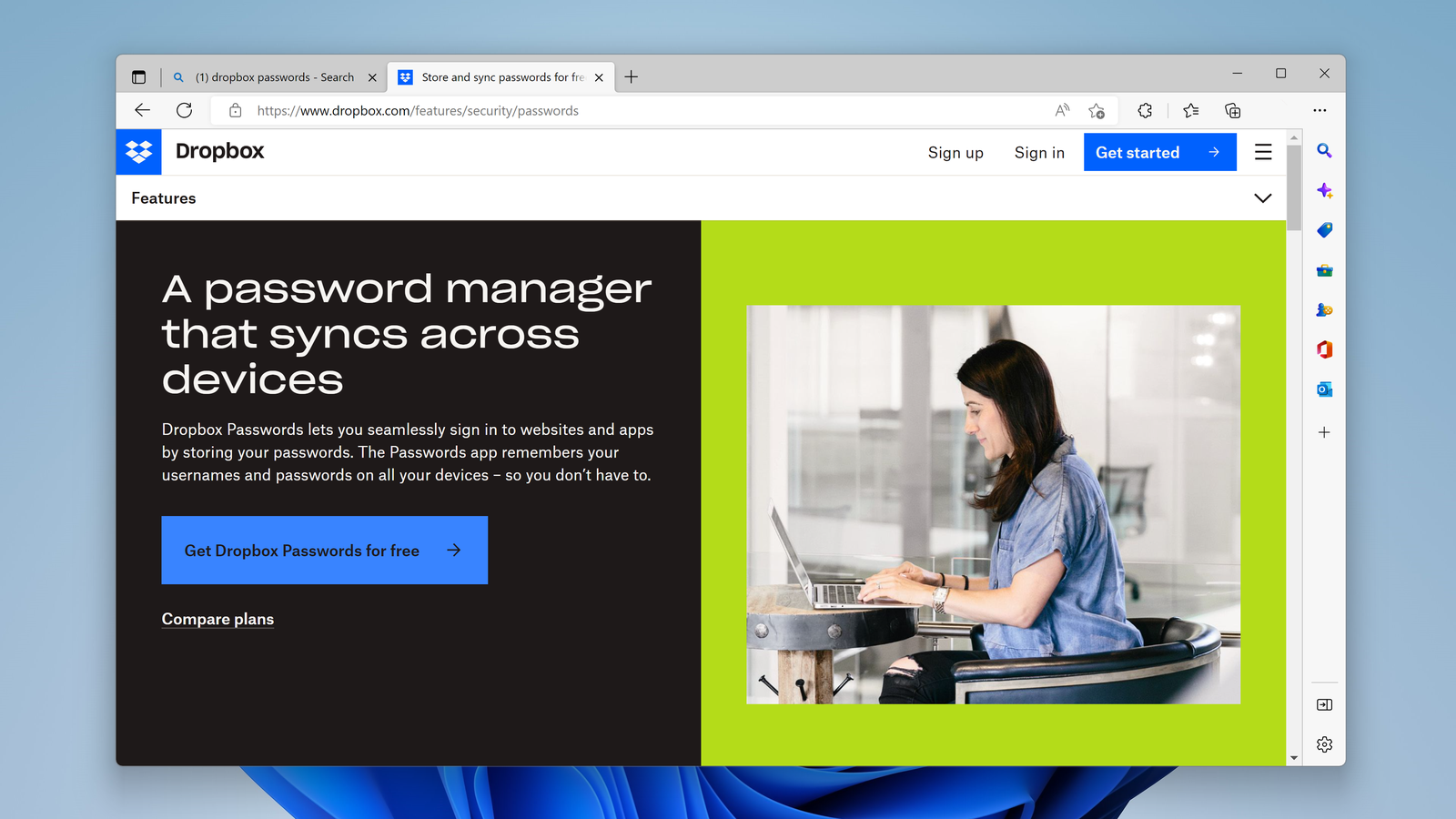TechRadar Verdict
Dropbox Passwords is a rock-solid choice if you want a free password manager that doesn’t go overboard on tech-heavy features, but other free options are better – and the paid options are only worthwhile if you want cloud storage features too.
Pros
- +
Easy, straightforward design
- +
Good security protocols
- +
Free cloud storage
Cons
- -
Few high-end features
- -
Dedicated password managers are cheaper
Why you can trust TechRadar
There aren’t many bigger names in online storage than Dropbox, but fewer people know about its Dropbox Passwords product.
It’s been a free offering as part of the wider Dropbox suite since 2021, and it promises to deliver an effective password manager that’s easy to use – ideal for anyone who wants to beef up their security without the tech-heavy language and features you may have to wade through elsewhere.
Dropbox Passwords: Plans and pricing
Dropbox Passwords is free and a part of the wider Dropbox ecosystem – it’s included in the basic tier. With that product a single user gets 2GB of secure storage, the option to connect three devices and the ability to store fifty passwords. Beyond cloud storage and password storage, you get instant syncing, thirty days of file recovery and sharable links. For people who need basic password management and cloud storage, it’s compelling, although other free options like Bitwarden allow unlimited password storage across unlimited devices – albeit without cloud storage.
If you’re willing to pay, though, you get unlimited password storage and unlimited devices in every product tier. The Plus product costs $9.99 / £9 / AUD$15 per month if you pay annually, and it gives a single user 2TB of cloud storage, improved multi-factor authentication and loads of storage and sharing features. The family plan costs $16.99 / £16 / AUD$25 and enables those features for up to six users.
You’ve got more options if you want to use Dropbox in a business environment. The Professional tier delivers 3TB of storage alongside better sharing options. The Standard business product costs $15 / £15 / AUD$24 per user per month. It delivers 5TB of space and a six-month file recovery period. Unlimited space is available in the Advanced tier, which costs $24 / £22 / AUD$35 per user per month and also deploys better security. Enterprise pricing is available on request.
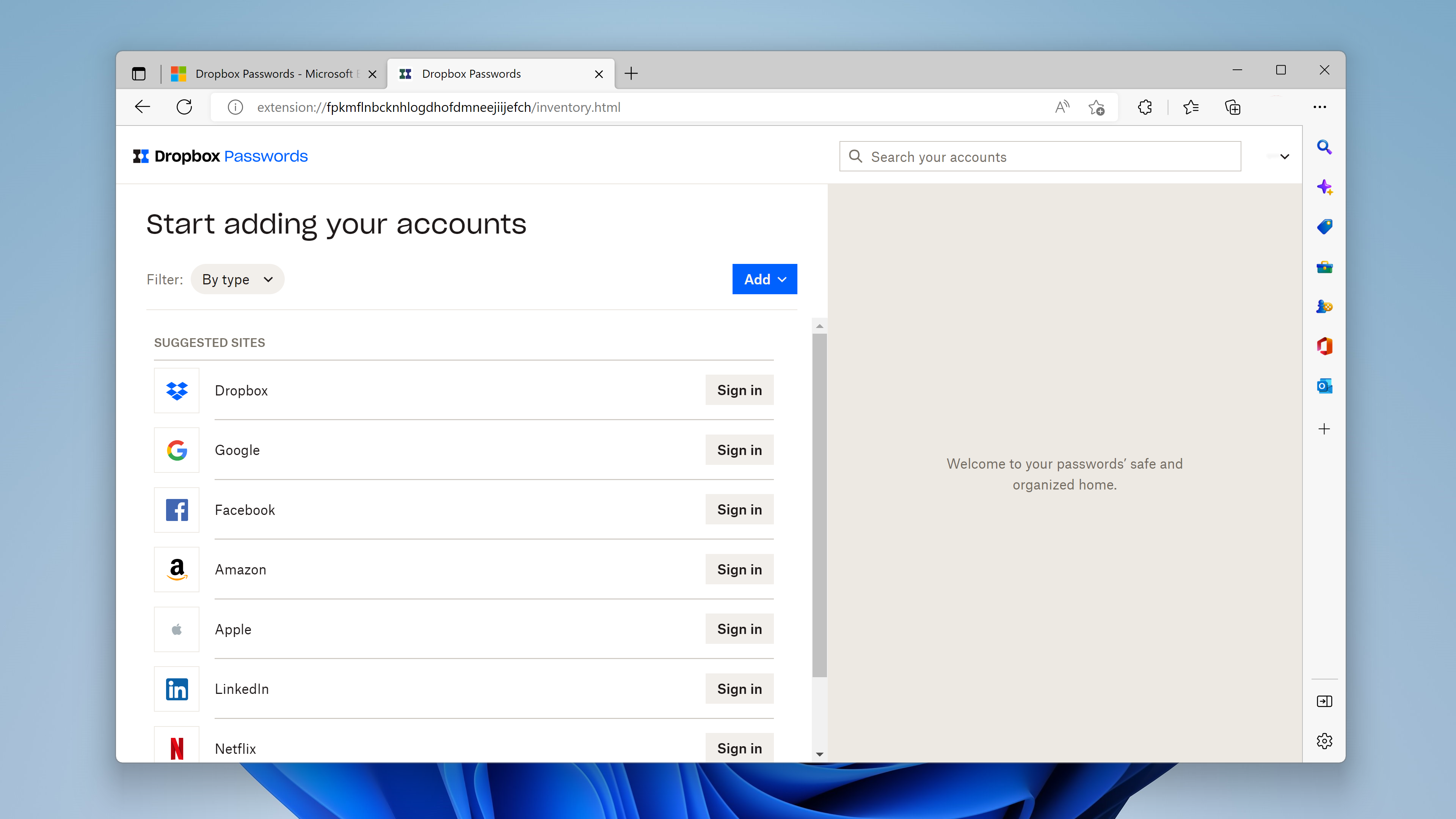
Dropbox Passwords: Setup
It’s easy to get started with Dropbox Passwords, even for people without much techy knowledge. Sign up for a free Dropbox Basics account and verify your email address and you’ll be right into the browser extension.
The setup process is designed to make password storage as seamless as possible. The app gives users a list of common apps, like Google, Facebook and Amazon, that can be added quickly and easily – so you can start saving passwords immediately. If you want to add your own, a separate window allows you to log your username, password and any notes, and Dropbox Passwords also supports payment cards.
Existing passwords can also be imported from Chrome and Firefox and directly from CSV files that have been exported from other password managers. You can also use Dropbox to create your own password export as a CSV.
Once you’ve saved a password, you can copy the credentials or simply use a link to open the site with the details already filled in. It’s very straightforward. This system works similarly on Dropbox Password’s iOS and Android apps. You’re also invited to create a passphrase to unlock your Passwords app, like the master passwords deployed elsewhere.
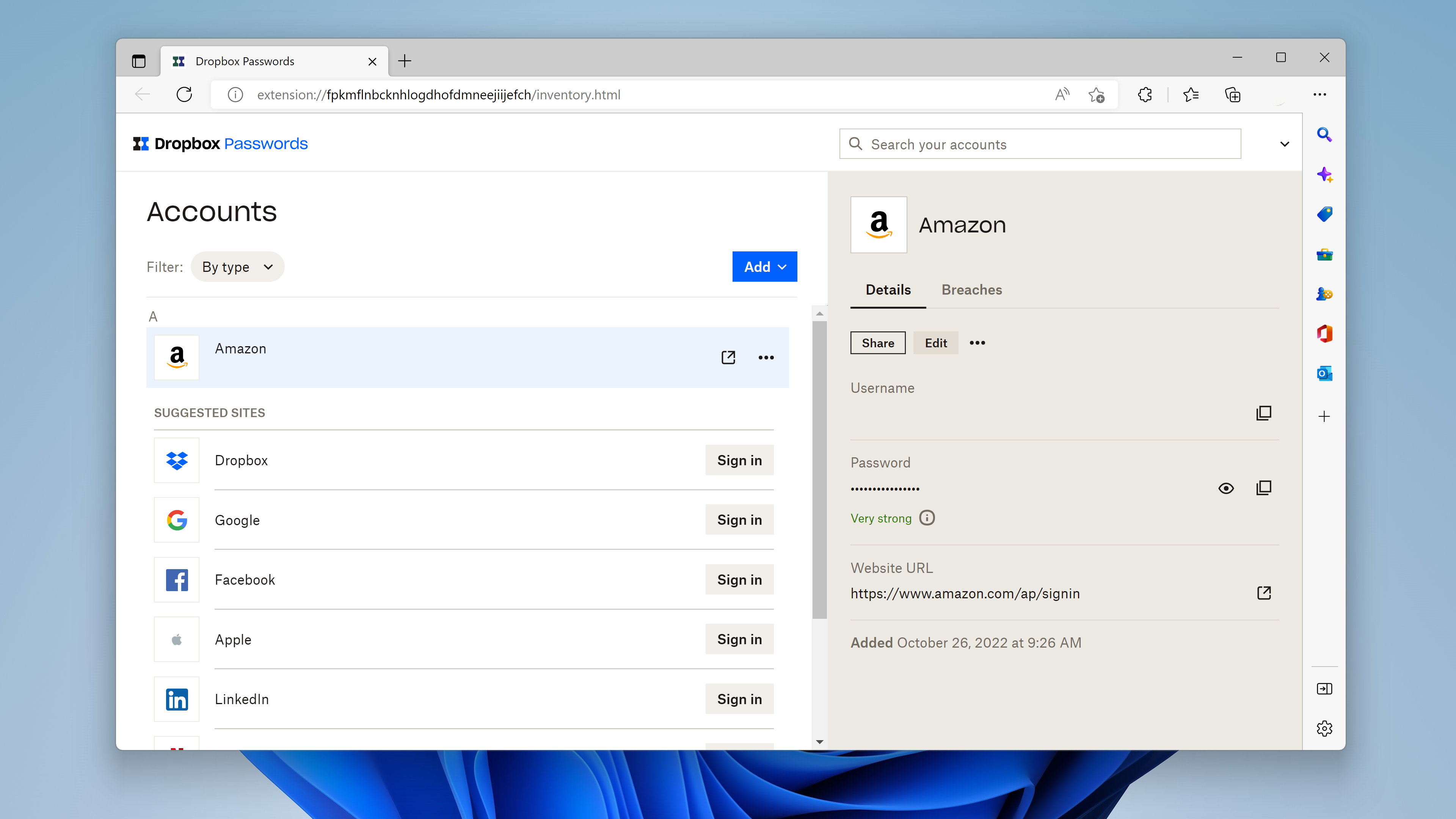
Dropbox Passwords: Interface and performance
More of the features included in Dropbox Passwords are tailored to ease of use. Select a password in the app and a separate window shows you its details and strength rating – but also highlights if it’s been involved in any breaches.
The app’s Security Dashboard is straightforward: one window gives you a big warning if your data has been compromised, and a second window delivers alerts for weak or re-used passwords. You can also choose whether you monitor all of your email addresses or just a selection.
You can share passwords with other people – simply enter their email address and they’ll be invited to log in to their own Dropbox Passwords account. Editing an entry is similarly simple: type in the correct details and click save.
The interface is well-designed, too. It’s spacious, with large buttons, and it’s sensibly designed – the main screen delivers a simple list of passwords, and the Security Dashboard uses two straightforward windows. The settings menu is easy to use, with common options split into four categories and a slick graphic that illustrates how close you are to your storage and device limits. You’re not confronted with overwhelming technical data, so people without loads of tech knowledge won’t be intimidated.
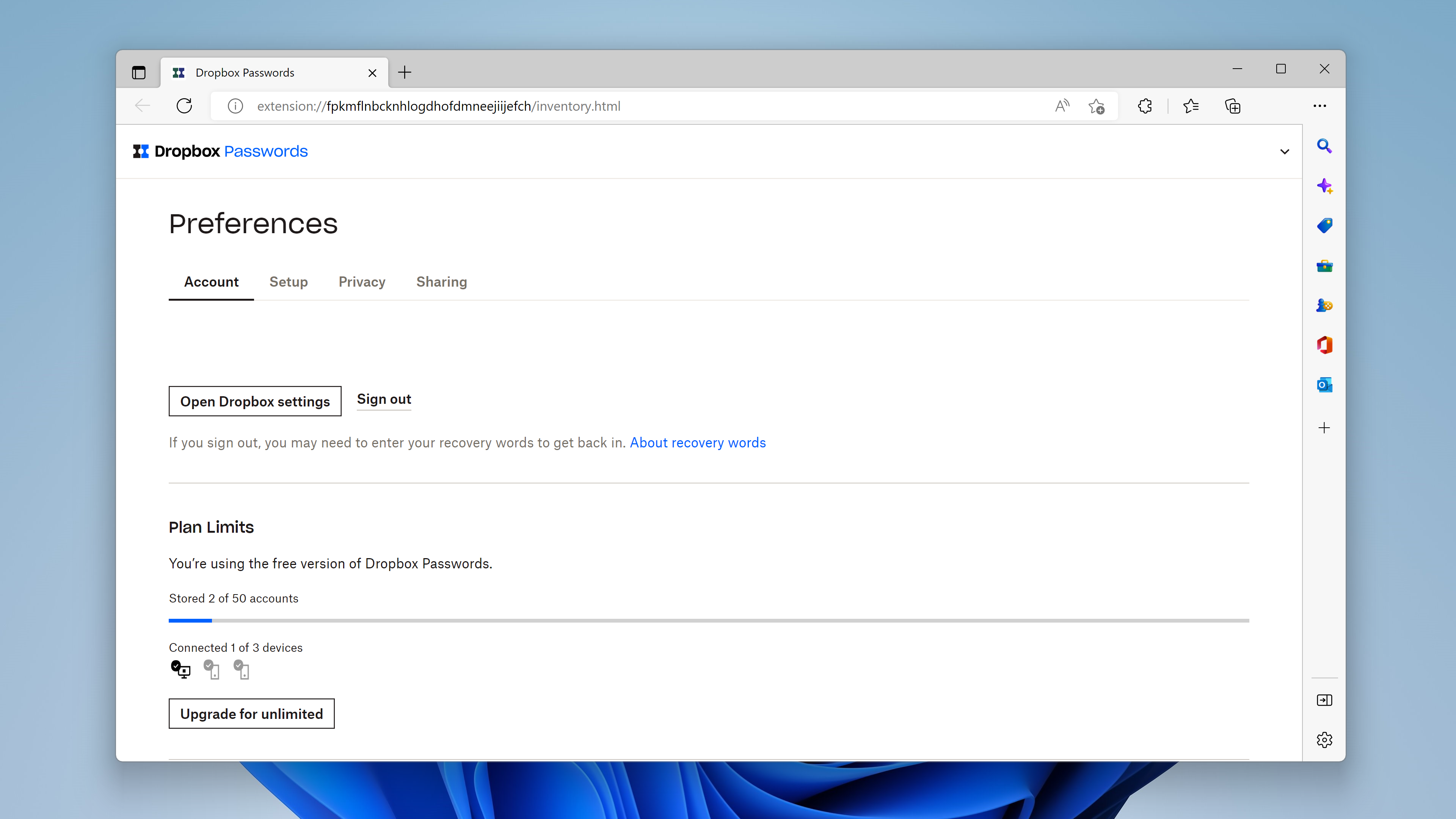
All of this makes Dropbox Passwords great for anyone who isn’t overly familiar with tech, or people who don’t need to store loads of passwords using a complex bit of software.
However, this simplicity means that Dropbox Passwords misses out on some features. You can add passwords or payment cards on this app, but most others include more categories and templates for saving a wider range of data – and some others also allow you to store more information in each listing, including documents and images, and let users add custom fields.
There’s more platform support elsewhere, too. Dropbox Passwords works on Windows and macOS and it’s got iOS and Android apps – and its browser extension functions in Chrome, Edge, Safari and Firefox. But look elsewhere and you’ll find extensions for a broader range of browsers and apps with Linux support.
Advanced features are absent, too. More import options are commonplace elsewhere, and some free tools even include unlimited cloud storage and optional self-hosting. Dropbox’s password generator allows you to customize the length of your password and opt to use symbols and numbers, but elsewhere you’ll find generators with more versatility, like the option to make passwords pronounceable.
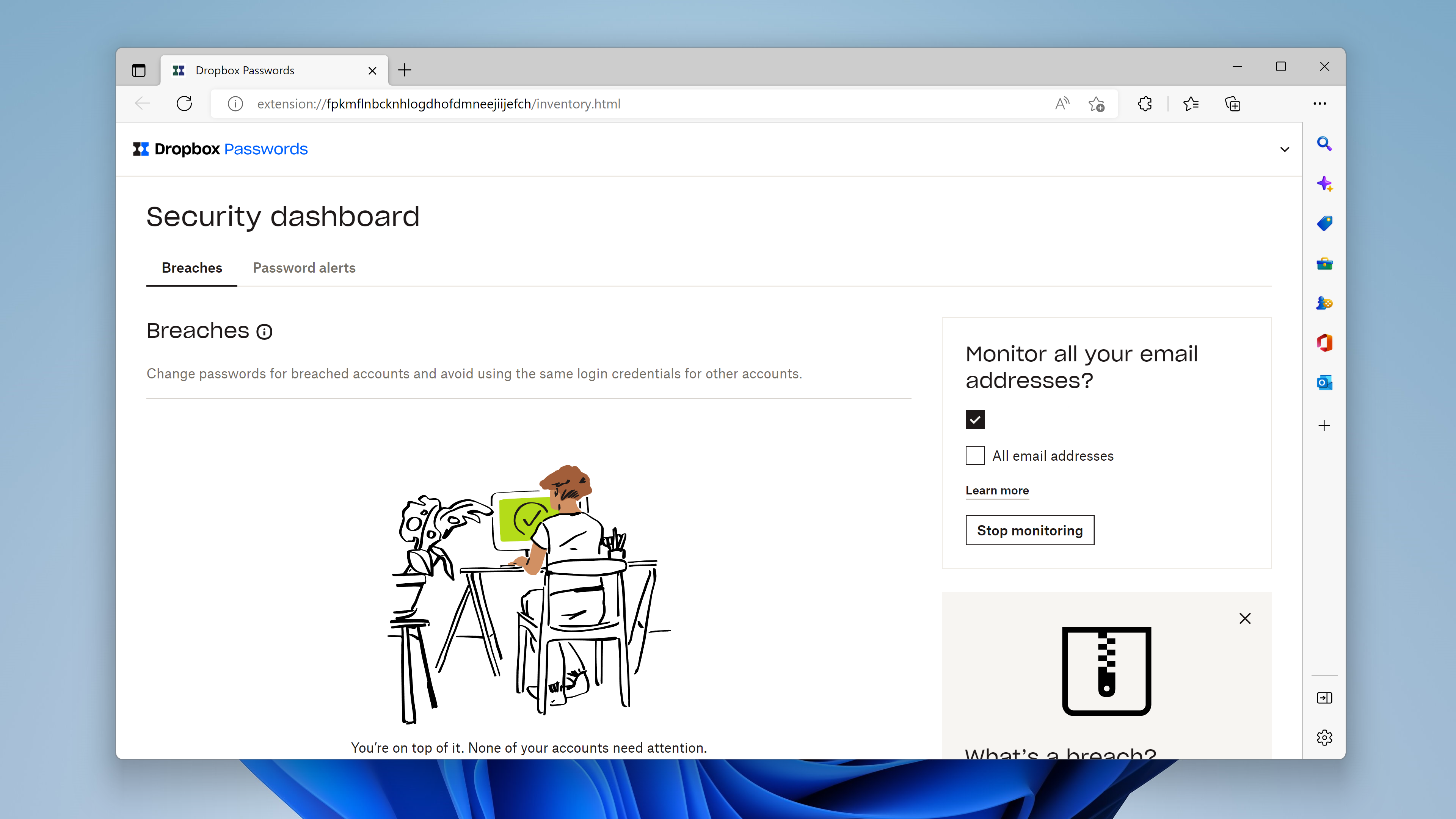
Dropbox Passwords: Security
Dropbox Passwords might lack high-end functionality, but there’s no quibbling with its security credentials. As with the rest of the Dropbox ecosystem, Passwords are protected with 256-bit AES encryption – a rock-solid industry standard.
SSL and TLS is deployed to protect data when it moves between Dropbox apps and the company’s servers, and the app can lock itself after a period of inactivity. Alongside using your passphrase to sign in, Dropbox Passwords can be unlocked with facial or fingerprint recognition and two-factor authentication. Dropbox is also a zero-knowledge provider, meaning no one at the company can access your data.
This is another area where you’ll certainly find more ability elsewhere, especially if you want high-end security options for organizations.
Dropbox Passwords: Support
Because Dropbox Passwords is included in every Dropbox product, the support on offer varies depending on which tier you’re using.
If you use the free Dropbox Basics product you can access live chat and an email form, and Dropbox also offers a Help Centre with a good selection of articles. There’s a forum, too.
Buy the Plus, Family or Professional plans and you get broadly similar options, although your emails are given priority. But if you upgrade to the Standard, Advanced or Enterprise plans, you get phone support too.
Dropbox Passwords: The competition
If you’d like a free password manager without the cloud storage component then you’d be better off with Bitwarden. It’s our current free favorite, and for good reason – it includes unlimited password storage and optional self-hosting, so it’s instantly a more versatile option than Dropbox.
If you want to upgrade to the paid plans then Dropbox looks more compelling, but we’d still recommend people look towards Dashlane or LastPass for pure password management. Both include broader ranges of password-specific features and both are cheaper than a Dropbox package, albeit without Dropbox’s enviable sharing and cloud storage capabilities.
Dropbox Passwords: Final verdict
Indeed, that’s the crux of the situation for Dropbox. As a free password manager, Dropbox is acceptable, especially if you don’t need advanced features. Combine the free product’s decent password management with 2GB of cloud storage and its robust security protocols and you’ve got a good option for anyone who needs fuss-free storage and password management.
Its paid products are better thanks to a market-leading range of cloud storage and sharing features, and all include Dropbox Passwords – although the price does quickly become steep when compared to pure password management software.
If you want a free password manager, then Dropbox Passwords gets the job done. But only spend cash on the paid tiers if you also want its cloud storage features.
Mike has worked as a technology journalist for more than a decade and has written for most of the UK’s big technology titles alongside numerous global outlets. He loves PCs, laptops and any new hardware, and covers everything from the latest business trends to high-end gaming gear.
